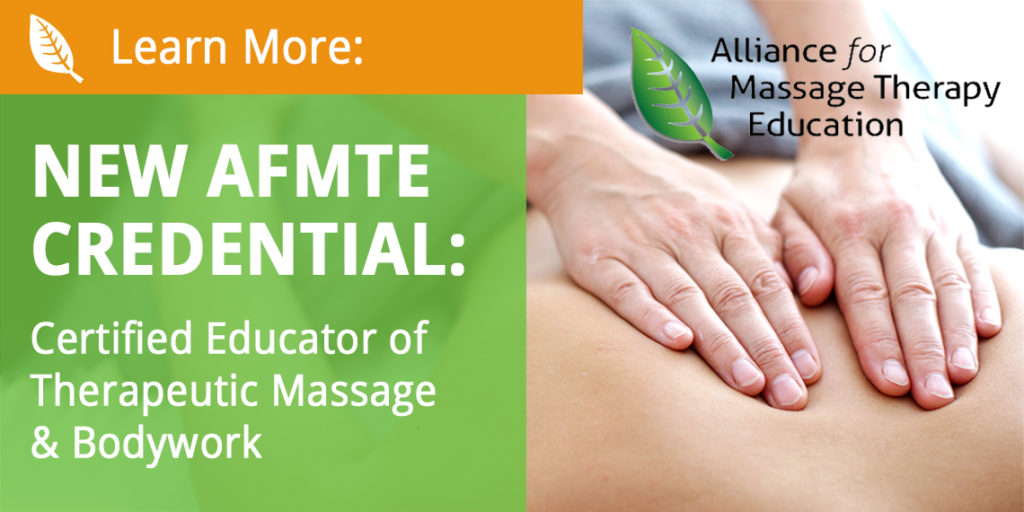AFMTE EDUCATOR CERTIFICATION PORTFOLIO APPLICATION PROCESS EXPLAINED WITH DEANNA SYLVESTER
Want to demonstrate your knowledge of best practices in therapeutic massage & bodywork education?
Deanna Sylvester explains how you can prepare your portfolio to apply to become a Certified Educator of Therapeutic Massage & Bodywork!
Here’s a quick review of what you’ll need for your portfolio to apply for the AFMTE Educator Certification Program. This new credential for therapeutic massage and bodywork educators is based on the AFMTE’s Core Competencies, which are a set of ten standards, each of which describes the knowledge, skills, and attitudes (KSAs) that form the basis for effective and successful teaching.
00:00 Hi folks! Deanna Sylvester here. I am the project manager for the Alliance for Massage Therapy Education’s Educator Certification project, and right now the application process for certification is done by portfolio review. And what that means is you have to prepare some evidence and we call that a portfolio so that your peers can review it and determine whether or not you meet the core competencies for massage therapy teachers and if you’re not familiar with
00:30 The core competencies make sure you check out the link below for an overview of what those are and the first step in the certification process really is to review those competencies yourself to determine whether or not you believe you meet those as an educator. The next step is to take a look at the list of portfolio items to determine what things you may already have that you can submit and what things you may need to create as part of your portfolio.
01:00 The first thing you should do is ask two people to write letters of recommendation for you to get that process started, and they need to be a supervisor administrator or a colleague someone who has observed your teaching and can comment on your competency in the National Teacher Education Standards and you’ll have them. Go ahead and write the letter to be submitted online, and during your application process you’ll enter their email addresses and we will contact them directly to have them submit their letters.
01:30 So then take a look at things you already have. So if you’re teaching class you probably have a syllabus or a course outline already prepared for that class you may even have lesson plans if you’re a continuing education provider. You might not have something specifically called lesson plans but what that is is really a detailed description of how you cover a particular topic or a series of topic in detail: how you present it; what activities you use to present it; how you determine whether the students are getting it.
02:10 So that would be your assessment process. Those are lesson plans, and you may need to create something if you don’t already have them. So let’s say you have a four-hour period in a workshop where you cover, I don’t know, tendinitis. So what you need to do is write down specifically is how you cover the topic of tendinitis in that four-hour period.
02:33 Lecture activities, demos assessments and other activities and other assessments, student feedback, things like that. And, for each of those lesson plans, you need to describe how you assess student learning, a summative assessment, and formative assessments. So if you’re a classroom teacher, you probably already have summative assessments in the form of a final exam or a practical and a rubric for your practical.
03:00 That would be your summative assessment. The formative assessments are the learning process as you go along: so how do you determine whether or not your students are learning during the process? So maybe you do a pre-quiz, you do some question-and-answer, maybe you have them journal about something now again. If you’re a supervisor, you might not have any. You might not test your students at all. You might not have any formal assessments, but you do evaluate your students’ learning because you’ve got to be able to tweak your your class as you go along/
03:37 Every time you give that workshop, you’re needing to make sure you’re doing it to the best of your ability as an educator, so think about the process that you use that you use to determine whether or not students are getting what you’re teaching them. That’s assessment, and you need to write that down and describe it.
03:58 So that the reviewers who are looking at your portfolio can determine how you meet the core competencies. You’re going to need to submit instructor evaluations, and pretty much everybody has these so pull out the last evaluation so in the last class you taught and scan them all and submit those. Or better yet, if you’ve already got a summary or maybe your school provides a summary for you, then just submit the summary of the class that you taught.
04:26 And then there are a few things you’re gonna have to create: one is your statement of interest. So you’re going to want to tell us why do you want to be certified and how do you meet the core competencies? You might want to address all ten of the standards in your statement of interest. You want to tell us your teaching philosophy, and how that aligns with the core competencies. You want to discuss your approach to teaching, your approach to learning, your understanding of the learning process, the learning environment and finally you’re going to need to create some videos of you teaching.
05:00 You need two of them; they need to be between five and ten minutes long, each of them, and you have to appear in the video frame like this. Probably you’ll be standing up in the classroom, and we need to see you discussing a topic interacting with students answering student questions.
05:23 A couple of those things will give us a good idea of your approach to teaching. Now I make videos like this all the time, and I do it on an iPhone so if you need help or just some tips on how to set up and create a simple video of you teaching, I’d be happy to help so give us a call (AFMTE’s phone number is 520-329-2627).
05:43 So get started compiling this information! Download the application information packet so you can use the checklist to keep track of your portfolio items as you put them together. And if you have any questions at all, please give us a call! We are here to help, and we really look forward to receiving your portfolio and reviewing it and hopefully getting the chance to award you the certified educator of therapeutic massage and bodywork credential!

